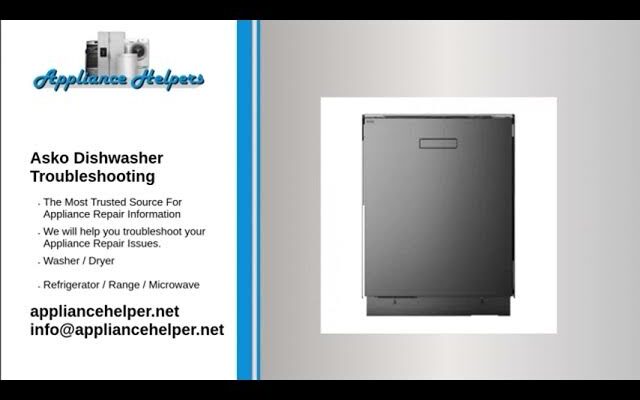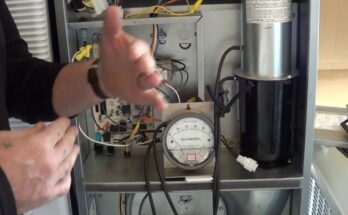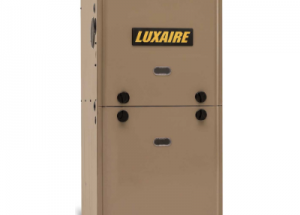To troubleshoot an Asko dishwasher, check for common issues like power supply problems or clogged filters. Resetting the dishwasher often resolves minor glitches.
Asko dishwashers are known for their reliability and efficiency, but like any appliance, they can encounter problems. Understanding how to troubleshoot these issues can save time and money. Start by examining the power supply to ensure the dishwasher is receiving electricity.
Inspect the filters for clogs, as this can affect performance. If the dishwasher still doesn’t function correctly, consider resetting it. This simple step can often resolve minor software glitches. Regular maintenance and proper use can also prevent many common problems, ensuring your Asko dishwasher runs smoothly for years.
Common Issues
Asko dishwashers are reliable, but sometimes they face problems. This section will help you understand and fix common issues with your Asko dishwasher.
No Power
Sometimes your Asko dishwasher may not turn on. Here are some common causes and solutions:
| Possible Cause | Solution |
|---|---|
| Tripped Circuit Breaker | Check your home’s circuit breaker. Reset it if tripped. |
| Power Cord Issues | Ensure the power cord is securely plugged in. |
| Faulty Outlet | Test the outlet with another device. Replace the outlet if needed. |
| Blown Fuse | Inspect the fuse in the dishwasher. Replace it if blown. |
Water Leaks
Water leaks can cause serious damage. Here’s how to fix them:
- Check Door Seal: Inspect the door seal for cracks. Replace if damaged.
- Inspect Hoses: Ensure hoses are tight and not cracked.
- Check Float Switch: The float switch may be stuck. Clean or replace it.
- Examine Spray Arms: Ensure spray arms are not clogged. Clean them regularly.
If the leak persists, contact a professional technician.
Error Codes
Is your Asko dishwasher displaying error codes? Understanding these codes helps in fixing issues quickly. Error codes are a way your dishwasher communicates problems. This section will guide you through interpreting these codes.
Interpreting Codes
Error codes on your Asko dishwasher provide specific information. Each code corresponds to a unique issue. Knowing what each code means can save time and effort.
| Error Code | Description |
|---|---|
| E1 | Water supply issue |
| E2 | Drainage problem |
| E3 | Heating problem |
| E4 | Water overflow |
Common Error Codes
Some error codes are more common than others. Here are a few you might encounter:
- E1: The dishwasher cannot get water. Check the water supply.
- E2: The dishwasher cannot drain water. Inspect the drain hose.
- E3: The dishwasher cannot heat water. The heating element might be faulty.
- E4: The dishwasher has too much water. It could be a leak or overfill.
Understanding these error codes can help you troubleshoot your Asko dishwasher. Follow the table and list to identify and fix problems easily.
Cleaning Tips
Cleaning your Asko dishwasher is important. It ensures the machine runs smoothly. It also extends the lifespan of the dishwasher. Here are some easy cleaning tips.
Regular Maintenance
Regular maintenance helps keep your dishwasher in top shape. Follow these simple steps:
- Wipe down the door seal with a damp cloth.
- Remove food debris from the filter.
- Run a hot cycle with an empty dishwasher.
Check the spray arms for any blockages. Ensure the detergent dispenser is clean. Doing these tasks weekly helps a lot.
Deep Cleaning
Deep cleaning is necessary every few months. This will get rid of any build-up. Follow these steps:
- Remove and clean the filter.
- Wipe down the interior walls with a damp cloth.
- Use a dishwasher cleaner solution.
Run an empty cycle with the cleaner. This removes any hidden grime. Check the door seal and clean it thoroughly.

Credit: www.manua.ls
Filter Care
Proper filter care is essential for your Asko dishwasher’s performance. Filters trap food particles, ensuring your dishes come out clean. Neglecting filter maintenance can lead to clogs and poor washing results. Follow these simple steps to keep your dishwasher in top shape.
Removing The Filter
Locate the filter at the bottom of the dishwasher. Turn it counterclockwise to unlock it. Lift the filter out carefully.
Cleaning The Filter
Rinse the filter under warm water. Use a soft brush to remove debris. Check for any damage or wear.
| Step | Action |
|---|---|
| 1 | Remove large food particles by hand. |
| 2 | Soak the filter in soapy water. |
| 3 | Scrub gently with a brush. |
| 4 | Rinse thoroughly under running water. |
| 5 | Let the filter dry completely. |
Once clean, reinsert the filter into the dishwasher. Turn it clockwise to lock it in place. Regular filter care ensures your Asko dishwasher runs efficiently.
Drainage Problems
Having drainage problems with your Asko dishwasher can be frustrating. Water pooling at the bottom of the dishwasher is a common issue. This can lead to poor cleaning performance and even damage. Let’s look at two main causes of drainage issues: clogged drains and pump issues.
Clogged Drain
A clogged drain is a frequent cause of drainage problems. Food particles and debris often block the drain. Follow these steps to check and clear a clogged drain:
- Turn off and unplug the dishwasher.
- Remove the bottom rack to access the drain.
- Check for visible debris or food particles.
- Use a soft brush or cloth to clean the drain area.
- Run a short cycle to see if the water drains properly.
Pump Issues
Another cause could be pump issues. The pump helps in removing water from the dishwasher. If the pump is faulty, water will not drain correctly. Here’s how to diagnose pump problems:
- Listen for unusual noises during the drain cycle.
- Check the pump filter for blockages.
- Inspect the pump impeller for damage.
- Consult the user manual for pump maintenance tips.
If you find any damage, you may need to replace the pump. Contact a professional for assistance if you are unsure.

Credit: www.yumpu.com
Loading Techniques
Proper loading techniques ensure your Asko dishwasher performs at its best. Follow these tips to avoid common issues and achieve sparkling clean dishes.
Proper Dish Placement
Place large items like pots and pans on the bottom rack. Ensure they do not block the spray arms. Cups and glasses go on the top rack. Place them upside down for better cleaning. Utensils should be spread out in the utensil holder. This prevents nesting and allows water to reach every surface.
Overloading Issues
Avoid overloading your dishwasher. Overloading can block water flow and result in dirty dishes. Load items in a way that allows water to reach every surface. Leave some space between items. This ensures better cleaning and drying.
| Item | Rack | Placement |
|---|---|---|
| Plates | Bottom Rack | Vertically, facing the center |
| Bowls | Top Rack | Angled, facing the center |
| Glasses | Top Rack | Upside down |
| Utensils | Utensil Holder | Spread out |
- Tip 1: Load larger items away from the center.
- Tip 2: Avoid nesting bowls and cups.
- Tip 3: Always place utensils handles down.
- Tip 4: Do not block the spray arms with large items.
Detergent Use
Using the right detergent is key for your Asko dishwasher. It ensures dishes come out clean and sparkling. The wrong detergent can lead to poor results and even damage. Let’s dive into how to choose the best detergent and troubleshoot common issues.
Choosing The Right Detergent
Choosing the right detergent can make a big difference. Powder detergents are often the best choice for Asko dishwashers. They dissolve well and clean effectively. Liquid detergents can sometimes leave residue. Tablet detergents are also a good option. They are convenient and pre-measured.
Check the manufacturer’s recommendations on the detergent packaging. This ensures compatibility with your Asko dishwasher. Avoid using regular dish soap. It creates too many suds and can cause issues.
| Detergent Type | Pros | Cons |
|---|---|---|
| Powder | Effective, dissolves well | Can be messy |
| Liquid | Easy to pour | May leave residue |
| Tablet | Convenient, pre-measured | More expensive |
Detergent Dispenser Issues
Sometimes the detergent dispenser may not work properly. This can lead to poor cleaning results. Here are some common issues and solutions:
- Dispenser doesn’t open: Check for obstructions. Clean the dispenser door if necessary.
- Detergent remains in the dispenser: Ensure the water temperature is hot enough. It should be at least 120°F.
- Dispenser is clogged: Use a toothbrush to gently clean it out.
If these steps don’t help, the dispenser might be faulty. Consider contacting Asko customer service for further assistance.

Credit: m.youtube.com
Professional Help
Even with regular maintenance, Asko dishwashers may encounter issues needing professional help. This section guides when to call a technician and finding reliable service.
When To Call A Technician
Some problems need expert attention. Here are signs to call a technician:
- Strange Noises: If your dishwasher makes unusual sounds.
- Water Leaks: Leaking water can cause bigger issues.
- Error Codes: Persistent error codes on the display.
- No Power: When the dishwasher does not turn on.
- Poor Cleaning: Dishes not coming out clean.
Finding Reliable Service
Finding a reliable technician is crucial. Follow these tips:
- Check Reviews: Look for reviews from other customers.
- Ask for Recommendations: Friends and family can help.
- Verify Credentials: Ensure the technician is certified.
- Get Multiple Quotes: Compare prices before deciding.
- Check Warranty: See if your dishwasher is still under warranty.
For your convenience, here’s a quick reference table:
| Issue | Action |
|---|---|
| Strange Noises | Call a technician |
| Water Leaks | Call a technician |
| Error Codes | Call a technician |
| No Power | Call a technician |
| Poor Cleaning | Call a technician |
Frequently Asked Questions
How Do I Reset My Asko Dishwasher?
To reset your Asko dishwasher, press and hold the “Start/Stop” button for 3 seconds. The dishwasher will reset.
Why Is My Asko Dishwasher Not Turning On?
Your Asko dishwasher may not turn on due to a tripped circuit breaker, faulty door latch, or a blown fuse. Check power connections and ensure the door is securely closed. Consult the user manual for troubleshooting steps or contact a professional technician if the issue persists.
How To Reset Asko Washing Machine?
To reset an Asko washing machine, unplug it for 5 minutes. Plug it back in and press the power button.
What Is The Life Expectancy Of An Asko Dishwasher?
The life expectancy of an Asko dishwasher is typically 10-20 years. Regular maintenance can extend its lifespan.
Conclusion
Resolving issues with your Asko dishwasher can be straightforward with the right guidance. Regular maintenance prevents most common problems. Always refer to the user manual for specific troubleshooting steps. By understanding your appliance, you can ensure it runs efficiently for years.
Keep your dishwasher in top shape for sparkling clean dishes every time.



